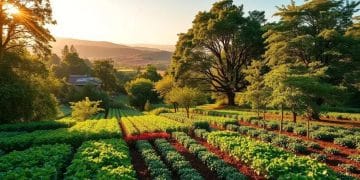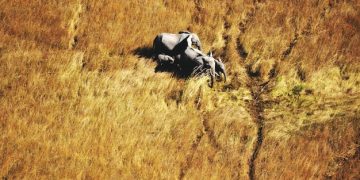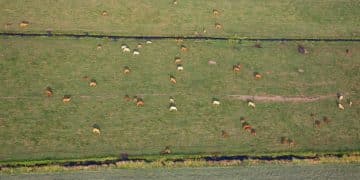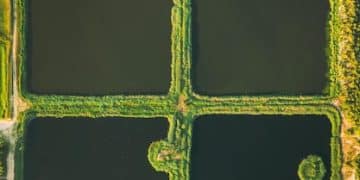Agroforestry Techniques: Improve Soil & Boost Farm Income
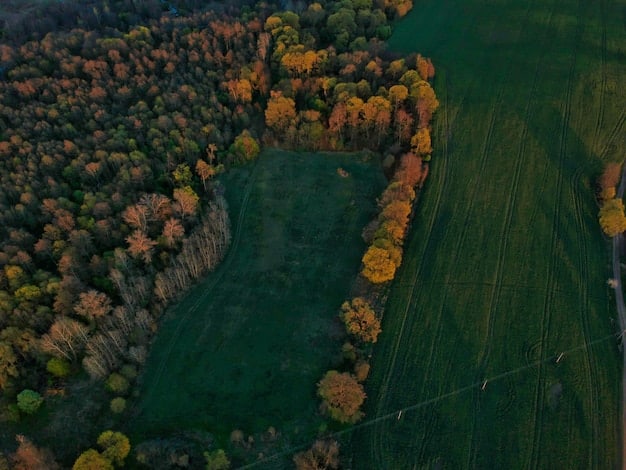
Learn how to implement agroforestry techniques to improve soil health, increase carbon sequestration, enhance biodiversity, and diversify farm income, creating a more resilient and sustainable agricultural system.
Discover how to learn how to implement agroforestry techniques to improve soil health and increase farm income. This approach combines agriculture and forestry, offering a sustainable solution for land management and enhanced productivity. Let’s explore how integrating trees and shrubs into farming systems can revolutionize your land and your livelihood.
What is Agroforestry and Why is it Important?
Agroforestry is more than just planting trees alongside crops; it’s a dynamic and integrated approach to land use. It strategically combines trees and shrubs with crops and/or livestock to create more diverse, productive, and sustainable farming systems. By mimicking natural ecosystems, agroforestry enhances ecological processes and provides multiple benefits.
Understanding the importance of agroforestry is crucial in today’s world, where sustainable agricultural practices are increasingly necessary. It offers a way to balance agricultural production with environmental conservation, improving both farm profitability and ecological health.
Key Benefits of Agroforestry
Agroforestry provides a wide array of benefits that stretch beyond simple crop production. It enhances soil health, increases biodiversity, and diversifies income streams.
- Soil Health Improvement: Trees improve soil structure, reduce erosion, and enhance nutrient cycling.
- Biodiversity Enhancement: Agroforestry systems provide habitats for beneficial insects, birds, and other wildlife.
- Income Diversification: Farmers can generate income from timber, fruits, nuts, and other tree-based products.
- Carbon Sequestration: Trees capture and store atmospheric carbon, helping to mitigate climate change.
Agroforestry is not only beneficial for the environment but also offers long-term economic advantages for farmers. It creates a more resilient and sustainable agricultural system, capable of withstanding environmental and economic challenges.
In conclusion, agroforestry is a powerful tool for creating sustainable and profitable agricultural systems. By integrating trees into farming practices, we can improve soil health, enhance biodiversity, and diversify income streams, resulting in a more resilient and sustainable future.
Selecting the Right Agroforestry System for Your Farm
Choosing the appropriate agroforestry system requires careful consideration of various factors, including climate, soil type, local market demands, and personal preferences. Different agroforestry practices are suitable for different environments and farming goals.
Before implementing any agroforestry system, it is important to conduct a thorough assessment of your farm’s resources and limitations. This will help you identify the most appropriate and effective practices for your specific situation.
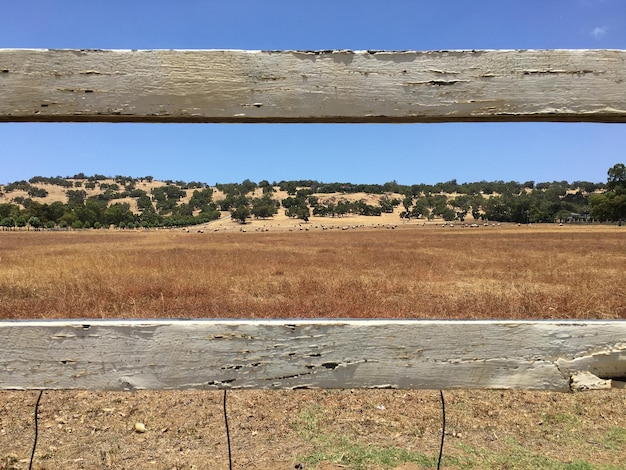
Common Agroforestry Systems
There are several common agroforestry systems, each with its own set of benefits and applications. Some of the most popular include alley cropping, silvopasture, forest farming, and windbreaks.
- Alley Cropping: Planting rows of trees or shrubs with crops grown in the alleys between them.
- Silvopasture: Integrating trees and livestock grazing on the same land.
- Forest Farming: Growing specialty crops under the canopy of a forest.
- Windbreaks: Planting rows of trees or shrubs to protect crops and livestock from wind.
Selecting the right agroforestry system depends on your specific farming goals and the environmental conditions of your farm. Consider the long-term impacts and benefits of each system before making a decision.
In summary, choosing the right agroforestry system is essential for maximizing its benefits and ensuring its success. By carefully considering your farm’s resources, goals, and environmental conditions, you can select the most appropriate and effective system for your needs.
Implementing Alley Cropping for Enhanced Crop Production
Alley cropping is a valuable agroforestry technique that involves planting rows of trees or shrubs with crops grown in the alleys between them. This system enhances crop production by improving soil health, providing shade, and reducing wind erosion.
By strategically combining trees and crops, alley cropping maximizes land use efficiency and creates a more resilient and sustainable farming system. It is particularly beneficial for farmers looking to diversify their income and improve the long-term health of their land.
Steps to Implement Alley Cropping
Implementing alley cropping involves several key steps, including selecting appropriate tree and crop species, preparing the land, planting the trees and crops, and managing the system over time.
- Select Suitable Tree and Crop Species: Choose trees that provide multiple benefits, such as nitrogen fixation, shade, and timber.
- Prepare the Land: Clear the land and prepare the soil for planting, ensuring good drainage and nutrient availability.
- Plant the Trees and Crops: Plant the trees in rows, leaving sufficient space for crops to grow in the alleys between them.
- Manage the System: Regularly prune the trees to maintain the desired shade level and prevent competition with the crops.
Alley cropping can significantly enhance crop yields and improve soil health. It is a cost-effective and sustainable approach to land management that offers both short-term and long-term benefits.
To conclude, implementing alley cropping requires careful planning and management. By following these steps, farmers can optimize crop production, improve soil health, and create a more sustainable and profitable farming system.
Silvopasture: Integrating Livestock and Trees for Sustainable Grazing
Silvopasture is an agroforestry practice that integrates trees and livestock grazing on the same land. This system enhances the productivity and sustainability of both livestock and tree production. It provides shade and shelter for livestock, improves forage quality, and diversifies income streams.
By combining livestock and trees, silvopasture creates a more diverse and resilient agricultural system. It enhances ecological processes and offers numerous benefits for both farmers and the environment.
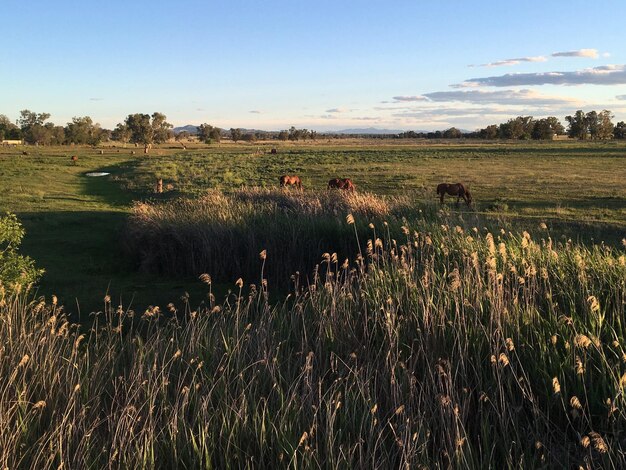
Benefits of Silvopasture
Silvopasture offers a wide range of benefits, including improved animal welfare, enhanced forage production, and increased carbon sequestration.
- Improved Animal Welfare: Trees provide shade and shelter, reducing heat stress and improving animal comfort.
- Enhanced Forage Production: Trees can improve soil fertility and water retention, leading to increased forage production.
- Carbon Sequestration: Trees capture and store atmospheric carbon, helping to mitigate climate change.
Silvopasture creates a more sustainable and resilient grazing system. It improves animal health, enhances forage quality, and provides additional income opportunities.
In summary, silvopasture is a valuable agroforestry practice for integrating livestock and trees. It enhances the productivity and sustainability of both livestock and tree production, creating a more resilient and profitable farming system.
Forest Farming: Cultivating Specialty Crops Under Tree Canopies
Forest farming, also known as woodland farming, involves growing specialty crops under the canopy of a forest. This practice can provide additional income and diversify the forest ecosystem. It utilizes the shade and protection offered by the trees to cultivate high-value crops.
By carefully selecting crops that thrive in shaded environments, forest farming can create a sustainable and profitable agricultural system. It offers an alternative to traditional agriculture and can enhance the value of forest lands.
Suitable Crops for Forest Farming
Several crops are well-suited for forest farming, including mushrooms, ginseng, goldenseal, and ramps. These crops thrive in shaded environments and can generate significant income.
- Mushrooms: Cultivating specialty mushrooms, such as shiitake and oyster mushrooms, on logs or in forest beds.
- Ginseng: Growing ginseng, a valuable medicinal herb, under the forest canopy.
- Goldenseal: Cultivating goldenseal, another medicinal herb, in shaded forest environments.
Forest farming can provide a sustainable source of income while enhancing the ecological value of forest lands. It requires careful management and a thorough understanding of the needs of the crops being cultivated.
To conclude, forest farming is a valuable agroforestry practice for cultivating specialty crops under tree canopies. It can provide additional income and diversify the forest ecosystem, creating a more sustainable and profitable agricultural system.
Windbreaks: Protecting Crops and Livestock from Wind Damage
Windbreaks are rows of trees or shrubs planted to protect crops and livestock from wind damage. They reduce wind speed, prevent soil erosion, and improve crop yields. Windbreaks also provide habitat for wildlife and enhance the aesthetic value of the landscape.
By mitigating the negative impacts of wind, windbreaks create a more favorable environment for agricultural production. They are particularly beneficial in areas with strong winds and exposed fields.
Benefits of Windbreaks
Windbreaks offer numerous benefits, including reduced soil erosion, improved crop yields, and enhanced animal welfare.
- Reduced Soil Erosion: Trees reduce wind speed, preventing soil erosion and preserving topsoil.
- Improved Crop Yields: Windbreaks create a more favorable microclimate for crops, leading to increased yields.
- Enhanced Animal Welfare: Windbreaks provide shelter for livestock, reducing stress and improving health.
Windbreaks are a cost-effective and sustainable approach to land management. They provide long-term benefits for both agriculture and the environment.
In summary, windbreaks are a valuable agroforestry practice for protecting crops and livestock from wind damage. They reduce soil erosion, improve crop yields, and enhance animal welfare, creating a more sustainable and productive agricultural system.
| Key Point | Brief Description |
|---|---|
| 🌱 Soil Health | Agroforestry improves soil structure, reduces erosion, and enhances nutrient cycling. |
| 🌳 Biodiversity | Agroforestry provides habitats for beneficial insects, birds, and other wildlife. |
| 💰 Income Diversification | Farmers can generate income from timber, fruits, nuts, and other tree-based products. |
| 💨 Wind Protection | Windbreaks protect crops and livestock from wind damage, reducing soil erosion and improving yields. |
Frequently Asked Questions
The primary goal is to create sustainable and integrated farming systems that combine agriculture and forestry, enhancing ecological processes and improving farm profitability.
Agroforestry improves soil health by improving soil structure, reducing erosion, enhancing nutrient cycling, and increasing organic matter content through the integration of trees and crops.
Yes, agroforestry can increase farm income by diversifying income streams through timber, fruits, nuts, and specialty crops, while also improving crop yields through enhanced soil health and protection.
The best system depends on your farm’s specific conditions, including climate, soil type, and market demands. Common systems include alley cropping, silvopasture, forest farming, and windbreaks.
Windbreaks protect crops and livestock from wind damage, reduce soil erosion, improve crop yields by creating a more favorable microclimate, and enhance animal welfare by providing shelter.
Conclusion
Implementing agroforestry techniques offers a sustainable and effective way to improve soil health and increase farm income. By integrating trees with agricultural practices, farmers can create more resilient, productive, and environmentally friendly systems, ensuring long-term sustainability and profitability.
